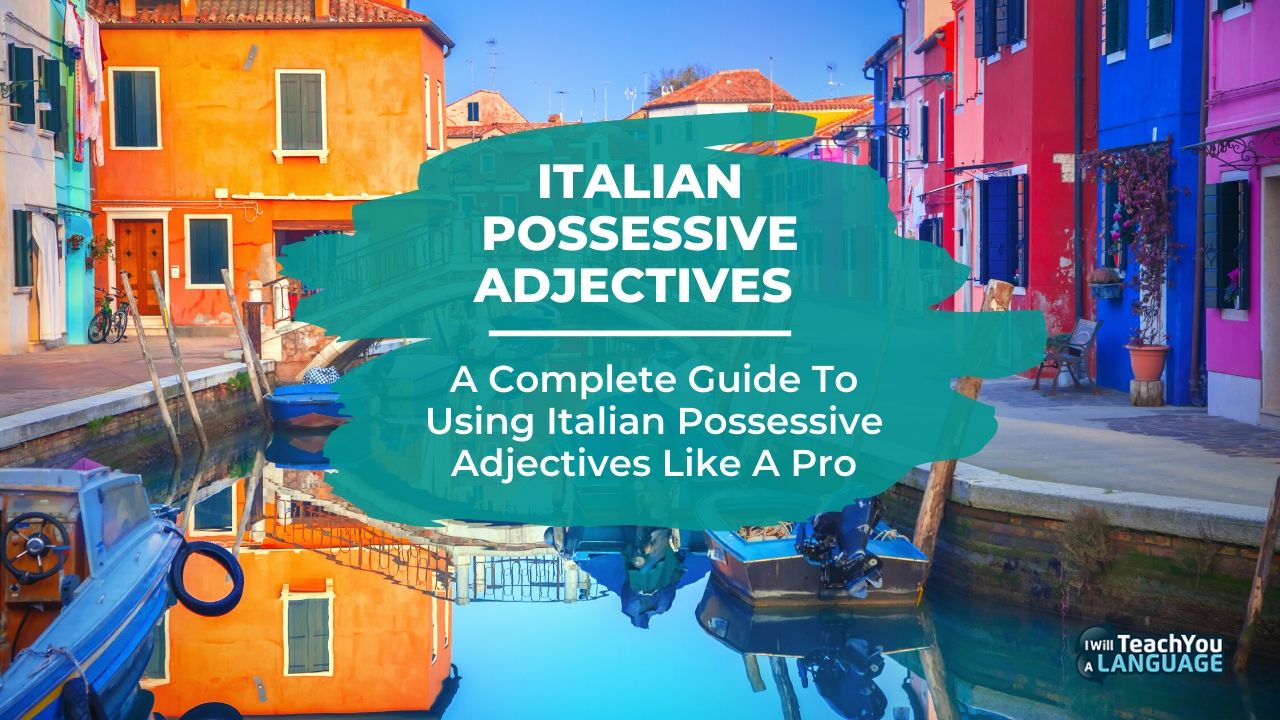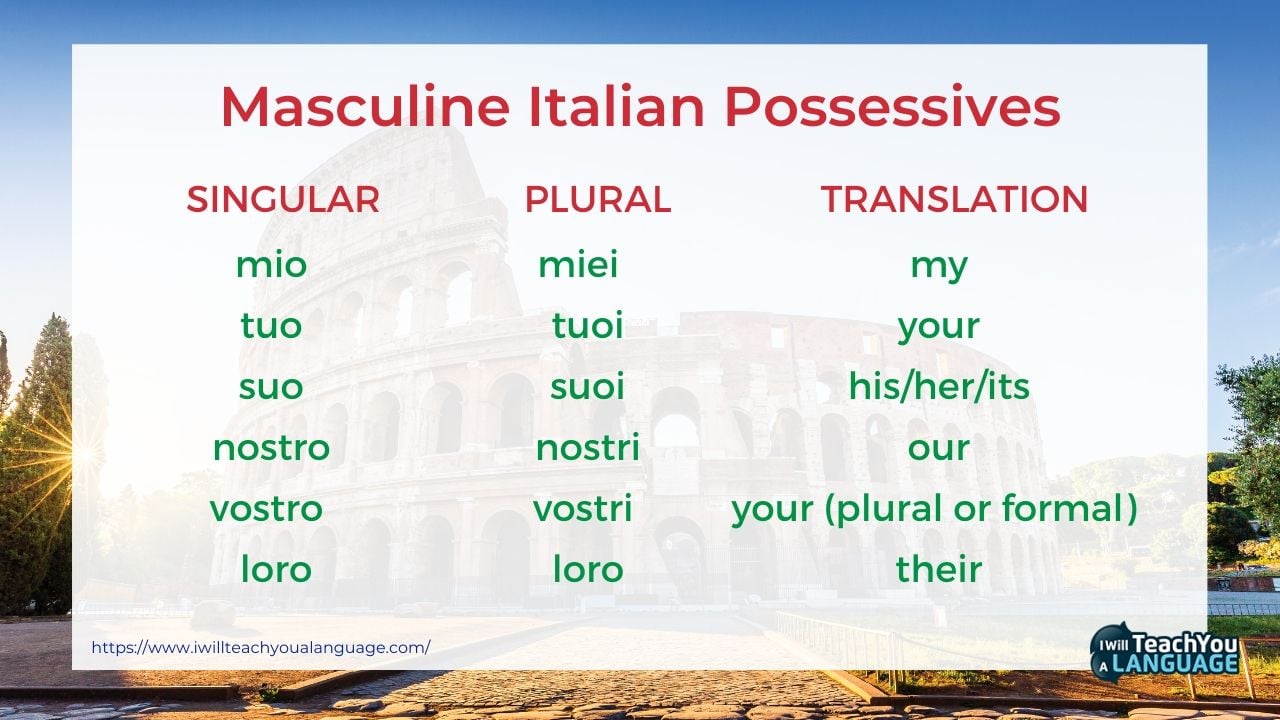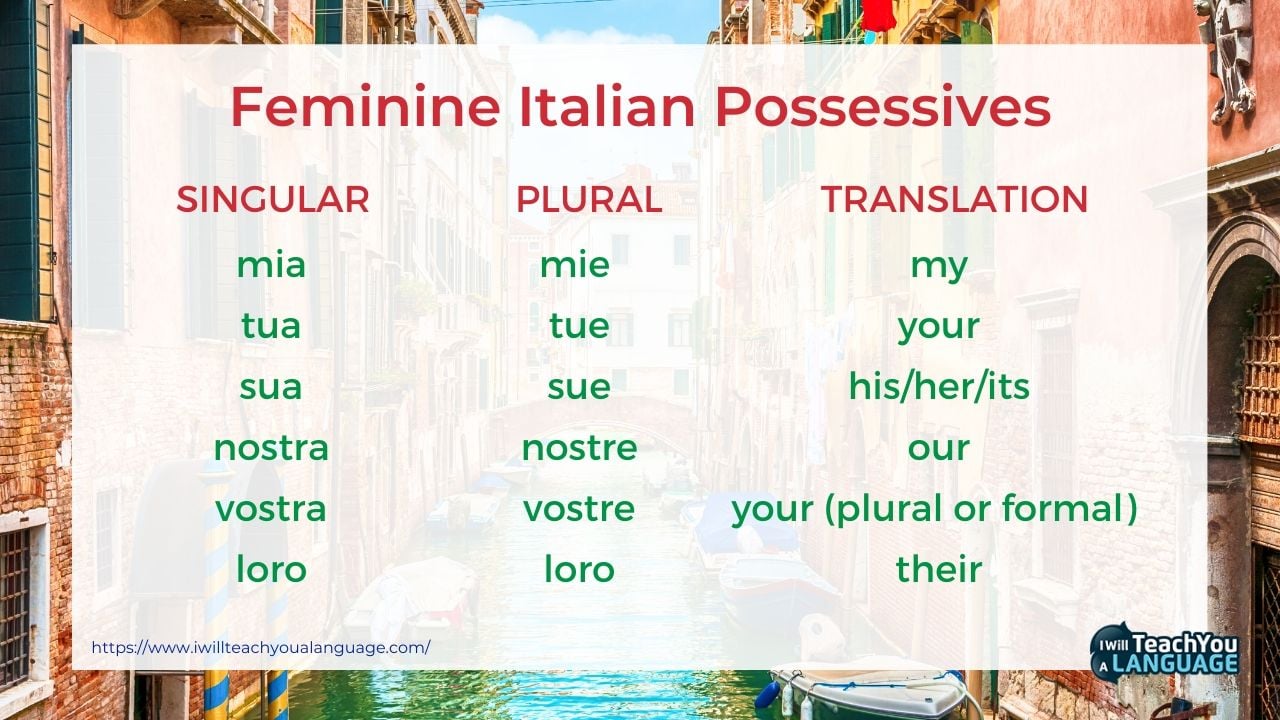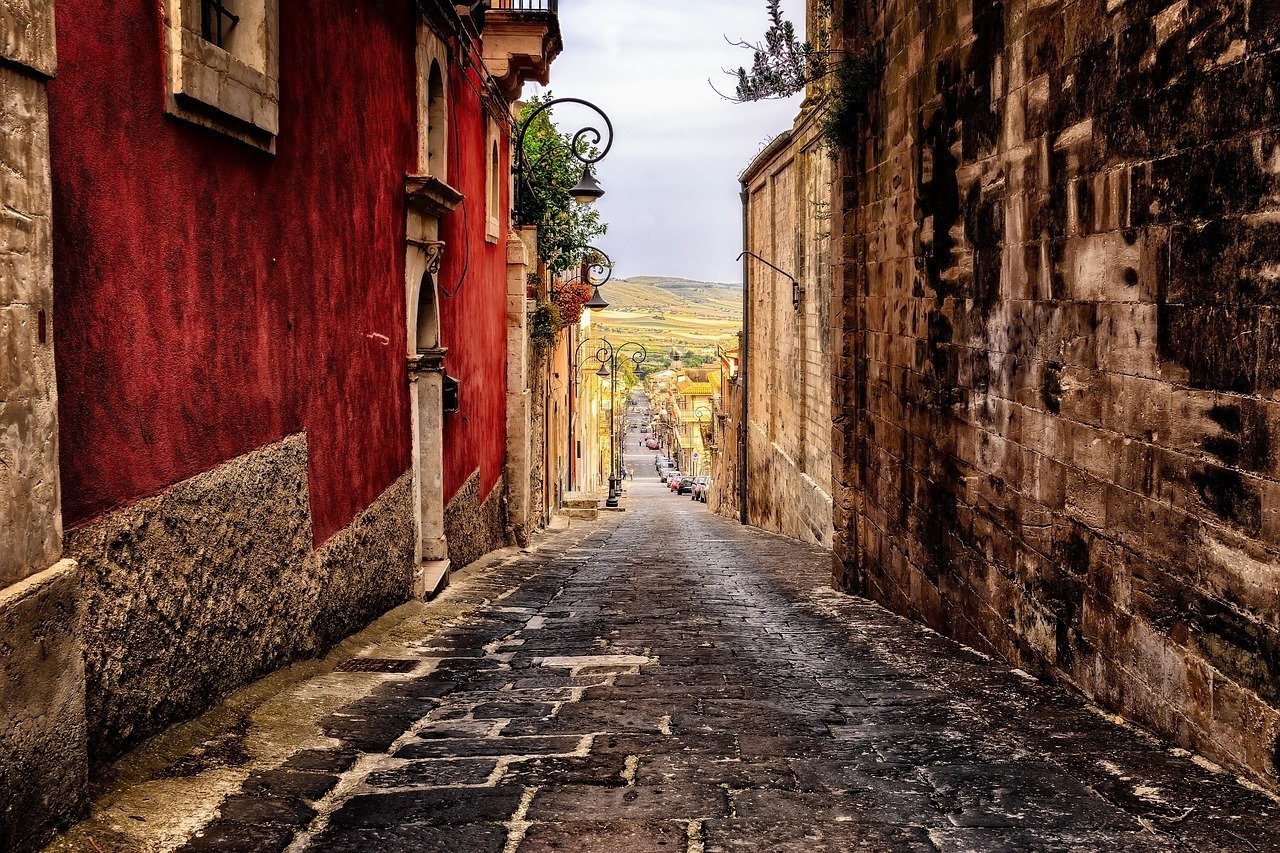
An important benefit of learning Italian or any other language is the way it allows you to learn about others and tell them things about yourself.
But to do this, you need a group of words that make an opinion yours, or that can express that the flowers in your hand are meant to be hers or that the beautiful house on the corner is your friend’s place.
This category of words is called possessives, or possessivi in Italian. These are there to signal that a thing, or a number of things, belong to a person or to a number of people.
Now, there are two factors that go into choosing the right possessive in Italian, and these take some getting used to because they aren’t present in the English language: gender and number.
But as you'll see, it's pretty easy to wrap your head around. After reading this post, you'll be using Italian possessive adjectives like a pro. So let's get into it.
By the way, if you want to learn Italian through stories, not rules, my top recommendation for language learners is my Uncovered courses, which teach you through StoryLearning®. Click here to find out more and get your free trial.
Table of Contents
The Gender And The Number Of Things In Italian
First, depending on whether you are talking about one object or more than one object, meaning a singular or a plural, the possessive changes.
An example word would be shoes. In English, whether you’re talking about a single shoe or a pair doesn’t matter, you’ll be talking about “my shoe” or “my shoes” — the only difference is when you say: “that shoe/those shoes are mine.”
In Italian, things look a little different.
Your single shoe is la mia scarpa, while your pair of shoes are le mie scarpe.
This brings us to the second point. In the above example, you can see that it says:
la mia scarpa
and
le mie scarpe.
La and le are feminine articles. This means that shoes, in Italy, are female. And that’s the other difference factor in Italian possessives — things, or words, have a gender, which in English they do not: everything is just “the.”
So to understand and use possessive adjectives Italian, you need to be familiar with articles. Let’s look at some examples of gendered possessives and what all of this means.
Masculine Possessive Adjectives Italian

Masculine, or male possessives are:
- mio/miei (plural) – my
- tuo/tuoi – your
- suo/suoi – his/her/its
- nostro/nostri – our
- vostro/vostri – your plural or formal Your
- loro/loro – their
Some rules and exceptions:
In Italian, the vast majority of nouns ending in “-o” are masculine. For example il gatto (the cat), or il treno (the train).
Strangely la mano, the hand, is female, as are all words that have been shortened to the letter “o” from longer words, like la moto, from la motocicletta (the motorbike),or la foto, from la fotografia (the photo). Speaking of female…
Feminine Possessive Adjectives Italian

Feminine, or female possessives are:
- mia/mie (plural) – my
- tua/tue – your
- sua/sue – his/her/its
- nostra/nostre – our
- vostra/vostre – your plural or formal Your
- loro/loro – their
Some rules and exceptions:
In Italian, most of the nouns ending in “-a” are feminine. So it’s la casa (the house), and la scuola (the school).
But nouns that end in “ma” are usually masculine, like for example il problema (the problem), and il cinema (the cinema) And then there are some masculine names that end in a, like Andrea, who is never a woman in Italy.
All nouns that end in “-tà” and “-tù” are feminine, like la felicità (the happiness) or la gioventù (the youth, as in someone’s youth).
Nouns ending in “i” are mostly female, like la crisi, the crisis, or l’analisi, the analysis, though il brindisi, the act of toasting to something with a drink, is male.
Words That Could Go Either Way
Nouns that end in “e” can either be masculine or feminine. So la mente, the mind, is female, but il mare (the sea), is male.
Some words have endings that suggest a gender: words that end in “igine”, “ione”, “udine”, “ite” or “ice” are feminine, like l’origine (the origin), la decisione (the decision) or la solitudine, (the solitude) and so on.
Also, all nouns that end in “ie” are feminine, like for example la specie (the type/kind of something).
All nouns that end in “ore” in turn are masculine, like il cuore, the heart, or il colore, the colour. The majority of nouns that end in “ame” “ale” “ile” and “ere” are masculine, as well.
For example il giornale (the newspaper) or il potere (the power to do something). But le ore, plural of l’ora, the hour, are feminine.
Words that end on a consonant, which tend to be unchanged words of foreign origin, are most likely male. Examples would be il computer or il toast. One exception is la star, which is feminine.
Why there has to be a gender to words is a mystery we won’t be solving today. It’s just one of those quirks about some languages, just like it is with Russian, German or Hindi.
At least in Italian, the form loro (their) does not change with the gender, though you’ll see why that might not be as simple as it sounds in a bit.
When To Use And When Not To Use Italian Possessives

When talking about family members — your own or someone else’s — in singular, you don’t need to use the article ahead of the possessive, unless specifying that something is one person’s instead of another's.
So you can say…
- Mia madre mi telefona ogni giorno. (My mother calls me every day)
and
- Tuo zio mi conosce? (Does your uncle know me?)
….instead of la mia madre or il tuo zio. The exception is when you want to say something specific about a person, so that it’s mia sorella, my sister, but la mia sorella maggiore, my elder sister.
You can also use the possessive if you say mamma instead of madre and papa instead of padre, so that la mia mamma is correct.
Note that while it’s not supposed to be done, many people still do this in casual conversation, so it’s really fine to do while you’re learning. Further below, I'll put the articles you don’t need to use in [parentheses].
Remember that in the plural form, the article is always needed, so that it’s:
- I tuoi fratelli sono più giovani? (Are your brothers younger?)
and
- Le tue zie ti amano. (Your aunts love you.)
The possessives of third person plural, or those used with loro also always use the article, whether singular or plural:
- Il loro cugino si chiama Francesco. (Their cousin is called Francesco.)
- La loro madre è arrivata. (Their mother has arrived.)
A Little More On Possessives And Gender

The gender of Italian possessive adjectives corresponds to the noun they are set before.
So in the case of a cat, which male even if your kitty is called Susan, this means that it will be referred to with the word mio, and if you’ve got a number of cats (and who doesn’t like cats), it’ll be miei:
- Il mio gatto beve latte. (My cat drinks milk.)
- I* miei gatti bevono latte. (My cats drink milk.)
*note how the article, il, becomes i in the plural.
For dog people, it’s the same rule, because the dog, il cane, is always a boy, too. But then, you’ve got animals that are always female, like the cow, la mucca. This adorable word stays female:
- La mia mucca è bianca. (My cow is white)
- Le mie mucche sono bianche. (My cows are white.)
*notice how in the plural, both the article, la, and the colour, bianco, change, as does mucca. If it was the cat to be white instead, bianco would become bianchi.
That’s because colours, too, change form with the gender of the thing they describe, though not always (isn’t that lovely). Verde (green) stays the same in male and female, so it’s il gatto verde and la mucca verde, though in the plural for both, it becomes verdi.
I know, it’s a little confusing. In English, what is gendered is the person you’re talking about, so that if your friend Lisa has a car, the car is hers. She owns the car.
But in Italian, the car is the one with the gender, so whether it’s Lisa or Joe who owns it, the car, la macchina, is female. But then, just when you thought that was it, here’s the plot twist: things change when they multiply, as you’ve seen above, as well.
So for example:
- Il suo gatto (His or her cat)
becomes:
- I suoi gatti (His or her cats)
…when he or she owns more than one cat.

Plural Italian Possessives

Now, let’s look at gendered nouns in the example of your, our, your (plural) and their.
For your, let’s take a feminine word, sorella or “sister”, and a masculine, fratello or “brother”. So if someone has one brother, you might say:
- [Il] tuo fratello è sempre impegnato. (Your brother is always busy.)
But if there are two brothers, it’s:
- I tuoi fratelli sono molto carini. (Your brothers are very cute/very nice)
(here, you can mean they look cute or are kind).
Same thing with sisters. One sister:
- [La] tua sorella è la mia vicina. (Your sister is my neighbour.)
…and a number of sisters:
- Le tue sorelle ballano bene. (Your sisters dance well/are good dancers.)
In the case of our, nostro, things are pretty easy. The singular looks like this:
- Il nostro cane non morde. (Our dog doesn’t bite.)
…while the plural looks like this:
- I nostri cani sono grandi. (Our dogs are large.)
or, in the example of a bicycle, which is female:
- La nostra bicicletta è nuova. (Our bicycle is fast.)
…and multiple bikes:
- Le nostre biciclette sono care. (Our bicycles are expensive.)
Your
Now, let’s look at “your,” the plural, as in you all, taking a feminine word, car, macchina, and a masculine, motorino, a small motorbike (like a vespa).
Singular masculine:
- Il vostro motorino è caduto. (Your motorbike has fallen down.)
Plural masculine:
- I vostri motorini sono caduti. (Your motorbikes have fallen down.)
Singular masculine:
- La vostra macchina è stata rubata. (Your car has been stolen.)
Plural feminine:
- Le vostre macchine sono pronte. (Your cars are ready.)
Loro
Now, we come to the last example: their, or loro, which doesn’t change according to gender or number, so that if we use the examples above, it’ll always look like this:
- Il loro gatto ha occhi verdi. (Their cat has green eyes.)
- I loro gatti non possono dormire dentro. (Their cats cannot sleep inside.)
- La loro macchina è lentissima. (Their car is very slow.)
- Le loro macchine sono grandi. (Their cars are big.)
- Il loro fratello mi ha chiamato due giorni fa. (Their brother called me two days ago.)
- Le loro sorelle sono gemelle e hanno i capelli biondi. (Their sisters are twins and have blond hair.)
When talking about “their” something, you’ll be able to determine the gender and/or the number of the something(s) by looking at the article ahead of loro, so il, i, la or le.
Possessive Adjectives Italian: Examples And Particular Cases

So now that you’ve got this down, let’s see some examples of how possessives might look when used in conversation.
When the possessive should come after the verb “to be” (or any of it’s variations, like are, is, was), you don’t need to use the possessive:
- Alessandra, questa borsa è [la] tua? (Alessandra, is this bag yours?)
- Sì, è [la] mia, grazie. (Yes, it is mine, thanks.)
- Questo è il mio motorino e quello è [il] suo. (This is my motorbike and that is his/hers.)
- Dammi il tuo numero e io ti mando un messaggio dal mio cellulare. (Give me your number and I will send you a message from my cell phone.)
- Il mio cellulare è nella sua macchina. (My phone is in his/her car.)
- Bene, allora prendi il tuo telefono, poi prendi anche la tua sciarpa che è sul* sedile. (Good, so get your phone, and then also get your scarf which is on the seat.)
And finally, a bit of trivia: as you now know, words like nel, nella, sulla, sullo or sul* change according to gender as well, so that it’s sul tavolo/al tavolo because il tavolo is male.
However, and this is as important as it is strange, once the table is set or about to be set for a meal, it becomes la tavola, so to eat, you sit down a tavola.
The gender of the table only changes when eating is about to start, so that to reserve a table you would call ahead and still prenotare un tavolo.
Possessive Adjectives Italian FAQ
What are the rules for possessive adjectives Italian?
Possessive adjectives in Italian must agree in gender (masculine or feminine) and number (singular or plural) with the noun they modify, not with the owner.
They are usually preceded by a definite article (e.g., il mio libro – my book). Exceptions include singular family members, where the article is omitted (e.g., mia madre – my mother).
What are the 7 possessive adjectives?
The seven possessive adjectives in Italian are:
Mio (my)
Tuo (your, singular informal)
Suo (his/her/your, singular formal)
Nostro (our)
Vostro (your, plural informal)
Loro (their/your, plural formal).
These change based on the gender and number of the noun, for example: mio/mia/miei/mie.
What are the rules for possessive pronouns in Italian?
Possessive pronouns Italian replace a noun and also agree in gender and number with the replaced noun. They are preceded by a definite article (e.g., Il mio è rosso – Mine is red).
Like adjectives, they take forms such as mio/mia/miei/mie depending on the noun they refer to.
What are aggettivi possessivi in Italian?
Aggettivi possessivi are possessive adjectives used to express ownership, such as mio (my) or nostro (our).
They agree in gender and number with the noun they modify and are used with a definite article except in some cases like singular family members (mia sorella – my sister).
Possessive Adjectives Italian
So there you have it – everything you need to know about understanding and using possessive adjectives in Italian.
As you've seen, getting used to using possessives correctly in Italian involves knowing some Italian grammar basics such as the fact that nouns have a gender, masculine or feminine. And that you'll usually have to modify your possessive adjectives when talking about plurals.
This makes the Italian version of possessive adjectives a little tricker to handle than their English equivalents. But the good news is that you'll hear these words all over the place as you listen to Italian podcasts. And you'll see them again and again as you read Italian books.
So get out there and immerse yourself in Italian so that you get plenty of exposure to Italian possessive adjectives in context. That's how you'll start using them naturally in your own speech.

Olly Richards
Creator of the StoryLearning® Method
Olly Richards is a renowned polyglot and language learning expert with over 15 years of experience teaching millions through his innovative StoryLearning® method. He is the creator of StoryLearning, one of the world's largest language learning blogs with 500,000+ monthly readers.
Olly has authored 30+ language learning books and courses, including the bestselling "Short Stories" series published by Teach Yourself.
When not developing new teaching methods, Richards practices what he preaches—he speaks 8 languages fluently and continues learning new ones through his own methodology.









































